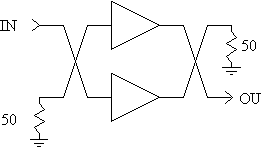General RF/Microwave Electronics |
|
Click here for the complete list of RF Cafe Quizzes. Note: Some material based on books have quoted passages.
c) Input/output impedance not dependent on devices as long as device impedances are equal. Due to the physical construction of the quadrature coupler, as long as the two devices between the couplers exhibit identical impedances the input and output impedances will exhibit the intrinsic coupler impedance. For example, if matched transistors with input impedances of 12 - j5 Ω are connected between to quadrature couplers that have an intrinsic impedance of 50 + j0 Ω, then a 50 + j0 Ω impedance would be exhibited at the circuit input (similar for the output). Why not always use quadrature couplers? The answer is that insertion loss, physical size and/or cost are often intolerable. 2. Why is there a frequency term in the equation for free-space path loss? c) Antenna geometry requires it. Antennas are an indispensable part of all wireless systems. There is no frequency dependency in the free-space power density equation as emitted from an isotropic radiator. Free-space power flux density decreases with distance due to energy being spread over the surface of a sphere, hence: P[density] = P[transmitter] / (4 π * d2) [W / m2], where d is the distance in meters from the origin. However, the gain of the receiving antenna, including its effective area (Ae) is: G = G[receiver] * l2 / (4 π) Total path loss = 20 * log (4 π * d / l) [dB]. 3. If an amplifier has a noise temperature of 60K, what is its noise figure for an ambient temperature of 290K? c) 0.82 dB. Conversion from noise temperature to noise figure is a straightforward process. NF = 10 * log [(NT / Ta) + 1] dB, where Ta is the ambient temperature. 4. What is a primary advantage of offset-quadrature-phase-shift-keying (OQPSK) over standard QPSK? c) More constant envelope power. OQPSK shifts the in-phase (I) and quadrature (Q) components of the digital data by half a bit so that the I and Q data never change at the same moment in time. This maintains a more constant output power. 5. A mixer has the following input frequencies: RF = 800 MHz, LO = 870 MHz. The desired output frequency is 70 MHz. What is the image frequency? a) 940 MHz.
By definition, the image frequency for any combination of input and LO frequencies is: fimage = 2 * fLO - finput. For any mixer, there are two input frequencies that, when mixed with the LO frequency, will generate the desired output frequency. In this example, the 70 MHz output can be generated either by taking 870 MHz - 800 MHz (desired), or by taking 940 MHz - 870 MHz (undesired). 6. What is the spurious-free dynamic range of a system with IP3 = +30 dBm and a minimum discernible signal (MDS) level of -90 dBm? a) 80 dB. Spurious-free dynamic range (SFDR) is the maximum signal power above the minimum discernible signal (MDS) power level where two tones generate 2nd-order intermodulation products equal in power to the MDS. Input signals above that level will generate 2nd-order products that are greater in power than the MDS power level. MDS is generally defined as the noise power plus the minimum signal-to-noise ratio (SNR) One form of the equation is: SFDR = 2 / 3 * (IP3 - MDS) dB. 7. A spectrum analyzer displays a component at 10 MHz @ 0 dBm, 30 MHz @ -10 dBm, 50 MHz @ -14 dBm, 70 MHz @ -17 dBm, and all of the other odd harmonics until they disappear into the noise. What was the most likely input signal that caused the spectrum? a) A 10 MHz square wave (0 Vdc bias). The Fourier series for a square wave with a 0 Vdc bias is the fundamental frequency and all of its odd harmonics. Amplitudes are scaled as the reciprocal of the harmonic number; in terms of power, the amplitudes are scaled according to 20 * log (1 / N) dB. A 10 MHz triangle wave also contains the odd harmonics, but amplitudes fall off according to the reciprocal of the square of the harmonic number, 40 *log (1 / N) dB. 8. On which side of a rectangular waveguide is an E-bend made? b) The short dimension. In a rectangular waveguide, the E-plane is in the direction of the short dimension while the H-plane is in the direction of the long dimension. The type of bend is determined by which side is curved for the bend. A useful mnemonic is the short dimension is the [E]asy side to bend, while the long dimension is the [H]ard side to bend. 9. During a network analyzer calibration, why are both a short circuit and an open circuit used? b) To determine the characteristic impedance of the measurement system. In order for the network analyzer (N/A) to make an accurate measurement, it must know what the impedance of the measurement system is. Characteristic impedance is mathematically the square root of the product of the short circuit impedance and the open circuit impedance. The S/A exploits this relationship. 10. What is the first harmonic of 1 GHz? a) 1 GHz. Harmonic number is often mistaken for overtone number. The second harmonic of 1 GHz is 2 GHz, while the first overtone frequency of 1 GHz is 2 GHz. In other words, Nharmonic = Novertone + 1. The first harmonic of any frequency is its fundamental frequency. |

 1. What
is a primary advantage to using 90 ° (quadrature) hybrid couplers in amplifier designs?
1. What
is a primary advantage to using 90 ° (quadrature) hybrid couplers in amplifier designs?